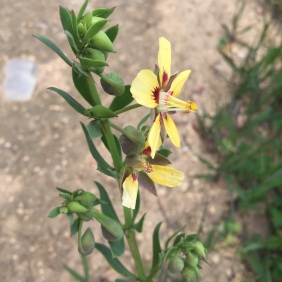Christmas flowers
The unidentified blue flowers I blogged last time have exploded everywhere on the farm, stunning and lasting quite a long time, so I decided I really should do a bit more research to identify them. The Colour Encyclopaedia of Cape Bulbs is a wonderful book and the dark spots on the lower petals helped give a clear identification. These are Thereianthus spicatus, considered rare and closely related to Micranthus, the combflower, also flowering prolifically after the fires. Part of their charm is that like the Micranthus they flower just as the season turns hot and dry. Here they are again.
Even with a houseful of guests and grandchildren, the Christmas break gives me an opportunity to spend more time out on the farm. In the mornings I get up before everyone else. The guests are all great runners at 10pm, less able and willing at 7am, so I head off on my own with the dogs more often than not. There are baby proteas growing everywhere, much to our delight, but I stop frequently to pluck them from the roads, in no time they will be large plants blocking the roads and it’s much easier to weed them out now, before they establish roots. Tomorrow I plan to bring a trowel and a plastic bag and to transplant some to the garden, as well as some of these Thereianthus spicatus which should do well in dry areas of the garden and give us some Christmas colour.
There are so many flowers that I have neglected to post over the last few months, so the rest of this post is an attempt to put up some of the most interesting in galleries, along with an idea of when they flowered, to serve as a record of how the farm recovered from the fire and to help us see how it changes over the next year.
First of all this lovely yellow rush which is suddenly everywhere. There’s a good reason we haven’t seen it before as it flowers mainly after fire. It shares the lands with the Thereianthus spicatus so we have tall yellow underlaid with purple-blue, stunning flashes of colour, especially along the drive as we come into the farm.
I really think these must be Ornithogalum though I’m not sure which sub-species, there are over 200 fynbos sub-species. These are growing in masses in one specific dam and rocky area. In the same area is this very sweet little purple flowering shrub which I haven’t identified. And flowering close to the river is the easily identified Ornitholagum dubium.
Another delightful purple flower is Pseudoselago spuria, the lilac powderpuff, which is quite common but until this year we hadn’t seen many on the farm. I haven’t seen Pseudoselago serrata, its close relation, which, until this year, has always made a reliable appearance by the weir.
From the same broad family comes the charming Selago corymbosa, a reliable friend each spring. I’m aware that some of my photos are not great – we’ve had a windy spring and early summer and often it’s been impossible to get a good picture. Yet if I don’t take it, the flower may be gone when we next get out, so these should be viewed as a record, and not as fine examples of the photographer’s art.
Masses of Roella triflora were to be found at the top of the farm in mid-November.
And along the drive, far less prolific than usual but delightful to see and as elegant as ever, the lovely Aristea capitata in November. The other stunning Aristea which flowers in spring, late September, is Aristea africana.
There are so many pelargoniums and I have not done a great job of capturing them. One of my favourites, the delicate Pelargonium myrrhifolium. Pelargonium elongatum is another plant that thrives after the fire, there are masses of them all over the farm this year. And up by the weir, this pretty pink Pelargonium which I haven’t identified. These huge leaves on this will serve to identify it one day.
This is Roepera, flexuosa I believe though it should be mainly costal and there are as many as 50 Roepera’s in the fynbos, so the subspecies may be another. We see it every year, it’s a lovely shrub.
And to finish, the queenly Gladiolus carneus, the painted lady. Ours doesn’t usually have the distinguishing splash of pink on the lower petals, but after years of hoping that we had our own unique sub-species, we’ve concluded, the experts and I, that this is indeed carneus. This charming flower lights up our mountain in November.



























































